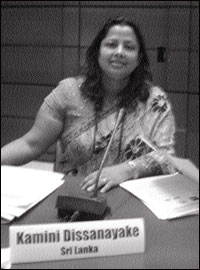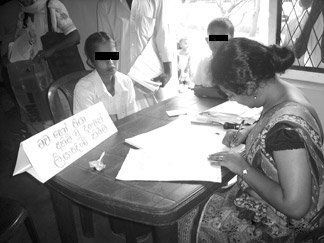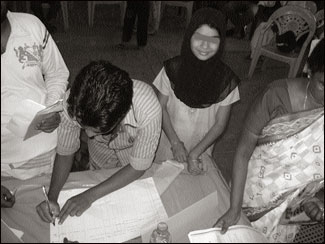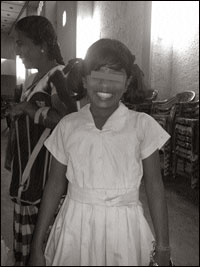|
For children affected by disasters:
Secure future based on law and justice
by Kamini DISSANAYAKE Attorney-at-Law

|

Registration of orphans at Hambantota |
The Law and Institutions of Justice are pillars of stability in our
communities. It is vital that they remain strong and relevant in times
of crisis. Natural disasters are beyond the capacity of any state to
prevent, but it is a necessity to ensure a 'secure future' based on law
and justice. The Law has a vital role to play not only in dealing with
issues in post-natural disasters, but in post-conflict situations as
well.
Sri Lanka is affected by many natural disasters every year. Floods,
landslides, drought and coastal erosion are some of the common disasters
faced by Sri Lanka every year.
The tragedy of December 26, 2004 was one of the deadliest natural
disasters in recorded history. The devastating tsunami that struck Sri
Lanka in December 2004 brought loss of life and destruction to the
coastal belt of the Northern, Eastern and Southern Provinces, crippling
the life of survivors and leading them to more uncertainty and
vulnerability.
Children are the most vulnerable group during and following a
disaster. Though there are domestic monitoring bodies with regard to
safeguarding the rights of children, the challenge faced in the
aftermath of the tsunami was to have in place a sustainable
institutional arrangement and a process that was capable of immediate
focused intervention.
Therefore, special legal provisions were made by the Tsunami Special
Provisions Act No: 16 of 2005 (TSPA) to enable children affected by the
tsunami to overcome legal barriers to ensure their protection. The said
Act extended the mandate of the National Child Protection Authority NCPA
(established by Act No. 50 of 1998) by authorising the NCPA to be the
guardian of every child placed under foster care by a parent and of
every child who is left an orphan, subject to the upper guardianship of
the Court.
Accordingly, the TSPA recognised three categories of children who
fall within the age group of 1-21 years, namely every child and young
person who is left an orphan; every child left with a single parent who
is unable to take care of such child; and every young person left with a
single parent who is in need of care and protection, which such parent
is unable to provide.
|

Re-survey at Karaithivu DS office |
The Act also authorised the NCPA to maintain a register containing
all information relating to every child who is left an orphan and every
child and young person who is in need of foster care protection.
According to the information provided by the NCPA, they carried out a
survey in 2005 and found that around 5,700 children fall within the
above three categories. At the time of the survey, these children were
in camps and temporary shelters. Therefore, a need was identified to
carry out a re-survey to ascertain the present status of these children
and their whereabouts.
As a result of the discussions held between the writer on behalf of
the Ministry of Justice and the NCPA with the Asian Development Bank, (ADB),
it was agreed to allocate funds to conduct a re-survey in all
tsunami-affected areas.
The ADB also provided funds to file foster care orders in Courts
under the Legal Assistance Program of the Tsunami Affected Areas
Rebuilding Project of the Ministry of Justice headed by the writer. The
ADB also provided an incentive scheme to encourage the beneficiaries to
register at re-survey clinics.
Under the Legal Assistance Program of the Ministry, I conducted 29
re-surveys in the Northern, Eastern and Southern Provinces with the
assistance of the Legal Officers at the Project Management Unit, NCPA
District Officers, District Secretariat Officers and Probation Officers.
Around 3,100 beneficiaries were registered at the re-surveys of which
1,634 were from the Northern and Eastern Provinces.
To date I have filed 334 foster care applications with the assistance
of the panel lawyers to strengthen the legal status and ensure the
protection of children who have lost both parents. Custodians were
provided with free legal assistance and representations in Court to
obtain foster care orders. Free legal aid panels were established in the
South, North and East with the support of the President of the Bar
Association. All registered beneficiaries received a Rankekulu account
worth Rs. 10,000 each.
Special features in TSPA
|

A tsunami victim |
Recognising the fact that exposure to natural disasters has a
devastating impact on the psychological and social well-being of
children, alternative measures such as registering as a current
custodian and having a child under foster care before filing an
application for adoption has been introduced by the TSPA. The Tsunami
Act specifically states that no Court shall entertain an application for
adoption of a child unless and until such child has first been placed in
foster care. Also, no adoption order shall take effect until the
expiration of a period of one year from the date of making the foster
care order. This permits the child to regain normalcy once basic
survival needs such as restoration of safety, security and developmental
opportunities within the social, family and community context are met.
The team came across a few custodians who have obtained Fit Persons
Orders from Court. A Fit Persons Order is valid only up to 14 years of
age and in the case of a young person up to 16 years. The foster care
order is valid up to a period of one year and is renewable annually
until the child reaches 21 years.
The most vital feature of the TSPA is the age group. Under the TSPA,
a child is a person who is less than 18 years of age and a young person
is somebody who has attained the age of 18 years but is under 21 years.
The Children and Young Persons Ordinance No. 48 of 1939 (CYPO) is the
principal legislation relating to children and young persons in Sri
Lanka, and in the interpretation clause (Section 88) a child is
identified as a person below the age of 14 years and a young person is
somebody who has attained the age of 14 years, but is under the age of
16 years.
The Age of Majority Ordinance No. 07 of 1965 made the age of 21 years
as the legal age of majority in Sri Lanka. The age of Majority Ordinance
was amended by an act in 1989. The amendment states that all persons
when they shall attain, or who have already attained, the full age of
eighteen years shall be deemed to have attained the legal age of
majority.
Another salient feature of the TSPA in Section 9 is that every person
having the custody of a child and a young person who is left an orphan;
and every child left with a single parent who is unable to take care of
such child; was required to make an application to the Commissioner of
Probations and Child Care Services for the purpose of being registered
as the current custodian. According to the Act a copy of such
information should be forwarded to the NCPA by the Commissioner.
If the person having custody of the child fails to register without a
just cause, such person will be guilty of an offence and upon conviction
will be liable to imprisonment of either description not exceeding two
years. This is the kind of special law that was needed to prevent
children and young persons falling prey to those who may subject them to
abuse and exploitation because of their vulnerability since the existing
laws were inadequate or did not have provision to provide quick remedy
and relief.
The Tsunami Special Provisions Act No 16 of 2005 was enacted at a
time that we had no national disaster management plan in place. The Sri
Lanka Disaster Management Act which was in Bill form in 2003 and
approved by the Supreme Court in the same year subject to certain
alterations was not presented to Parliament and came up for
determination before the Supreme Court again in 2005. It was finally
passed in March 2005.
Meanwhile, the Children and Young Persons Ordinance No: 48 of 1939 (CYPO)
which is the principal legislation relating to children and young
persons in Sri Lanka, does not define natural/conflict disaster related
interventions relating to children. It does not define a framework or
focused interventions or special institutional arrangements to address
the needs of natural/conflict related issues. It deals with establishing
juvenile courts, the supervision of juvenile offenders, the protection
of children and young persons and other connected purposes and
procedures.
Also, the creation of 30 guiding principles on internal displacement
in 1998 shows the obligation that governments and other authorities have
towards Internally Displaced Persons though not legally binding unless
in the case of Sri Lanka it needs to be incorporated into a domestic law
and passed by the Parliament to be enforced as a legal instrument as Sri
Lanka is a dualists country.
Therefore, recognising the importance of having in place a
sustainable institutional arrangement and a process that could provide
focused intervention, the enactment of the TSPA paved the way to
safeguard and protect the vulnerable children affected by the tsunami.
The TSPA Chapter (ii) does not address or have identified and placed
quick measures with regard to the property issues of children such as
misuse, encroachment, negligence, lack of title, Instituted actions
during or before the tsunami with regard to title, pensions of the
diseased parents which are current problems affecting these children.
There is no special mechanism to speed up resolving these issues.
Therefore, these issues will have to be dealt with the existing laws and
procedures which take time.
There are a few lacunas identified by me in this process. We do not
have and have not yet established a mechanism for the purpose of
establishing a good rapport with the children and understanding their
signs and symptoms to stressful events which is very essential at
disaster situations.
The Child Protection Authority is represented by one coordinator and
one psychosocial officer per district which is inadequate to represent
the entire community in the area. There is only one Child Rights
Protection Officer for each DS Division. One should have in mind that
these officers are stationed to represent all children not only
tsunami-affected children. Lack of professional ongoing training to
these officers to make them comfortable in dealing with children's
natural distress and recognise children who may need more specialised
support is much needed.
Unfortunately, some children especially those who are left with
single parents have faced traumatic events including, but not limited
to, neglect, physical and psychological abuse and various degrees of
abandonment due to the re-marriage of the living parent.
There is a dire need to seek solutions and be adoptive to many
mechanisms used in other countries. As an example, if separate units or
a mechanism could be set up together with the relevant authorities
preferably in schools to ensure that children have accessibility to
complain and with training to specialised personnel to receive
complaints and testimonials from children, a secure future with adequate
security for children would not be far away. The complaint procedure
should be accessible to children.
Consequences of the disaster
The consequences of the disaster are outlined herewith without
mentioning the names and whereabouts of the children to understand the
tragedy that the catastrophic waves have created in the innocent lives
of children. The victim's father died as a result of the tsunami. The
victim was only 15 years at the time. She has two younger brothers
(twins) who are 16 years of age now. Their mother abandoned the children
soon after the tragedy and according to the children the mother is
re-married now and lives in the North Western Province. The victim has
been sexually abused by a youth at the age of 15 and had given birth to
a child who is now two years old.
The victim referred to above is 17+ at the time of reporting this
event and reached the age of maturity in October 2009. They have no
custodian. Strangers have provided them with shelter as they had no
place to live. This matter has been reported to the NCPA.
There was a compliant by a mother affected by the tsunami. Her child
has not been accepted by any school in the area. All the schools have
rejected her applications for admission. When this matter was informed
to us, we on behalf of the victim communicated with the nearest school.
Since there was no response to the issue, the victim was directed to the
Human Rights Commission. On the request of the Ministry of Justice, The
Ministry of Education, after lengthy discussions, issued a circular with
regard to the admission of re-settled children to the nearest schools.
This circular helped the victim to win her case. Finally, the child was
admitted to a school at Panadura.
Humanitarian Relief
Disasters, man-made or natural, pave the way for opportunistic forces
to capitalise on the grief and misery of thousands of people who are
vulnerable at situations beyond their control. As a result, survivors of
the disasters will continue to face marginalisation, vulnerability and
most of the time uncertainty.
Unless the right to humanitarian relief is recognised as a part of
the development of society and unless a strong and well articulated
rights-based approach is recognised, disasters will continue to erode
the social fabric of communities. It is a must to protect the dignity,
and guarantee inter-related rights of affected individuals and
communities. When making decisions by the policymakers, their voices
should be heard and needs should be taken into account.
Though the focus is always on rescue, clean water, sanitation,
clothing, medical needs and temporary shelters in the aftermath of any
disaster, attention should also be devoted to a secure future based on
law and justice.
The TSPA is an example to prove that law has a vital role to play in
the recovery process. The law will play a major role on principles of
equality and non-discrimination in access to justice.
The writer is Project Consultant, Project Management Unit of the
Ministry of Justice. |

